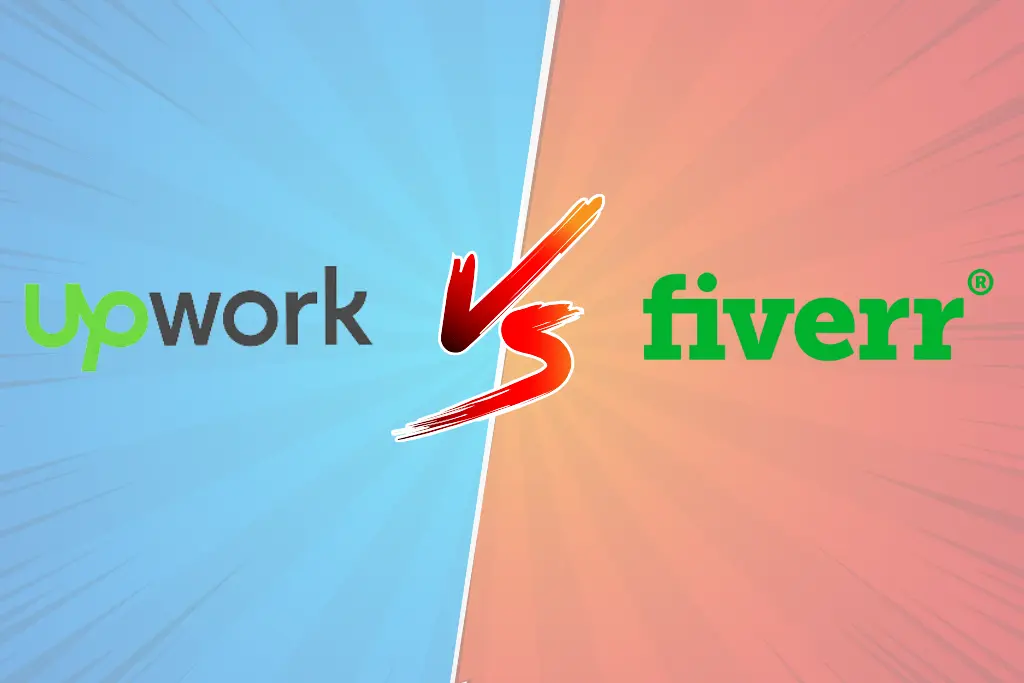Fiverr vs Upwork: Best Freelancing Platform Comparison

In the digital age, freelancing has emerged as a viable career option for many professionals around the globe. With the freedom to choose projects, set their own rates, and work from anywhere, freelancers are increasingly turning to online platforms to find work and connect with clients. Two of the most popular freelancing platforms are Fiverr and Upwork. Both offer unique advantages and cater to different types of freelancers and clients. This blog will provide an in-depth comparison of Fiverr and Upwork, exploring their features, pros and cons, and the best scenarios for using each platform.
Introduction to Fiverr and Upwork
Freelancing platforms have revolutionized the way people work and hire. Fiverr and Upwork are two giants in this industry, each with its distinct approach to connecting freelancers with clients.
Fiverr started as a platform where freelancers could offer their services, or “gigs,” starting at $5. Over the years, it has evolved into a marketplace where freelancers offer a wide range of services at various price points. Fiverr is known for its straightforward, gig-based system, making it easy for freelancers to list their services and for clients to purchase them.
Upwork, on the other hand, is a more traditional freelancing platform where clients post job listings and freelancers bid on them. It was formed from the merger of two major freelancing platforms, oDesk and Elance. Upwork offers a more structured and formal approach to freelancing, with a focus on long-term projects and professional services.
Fiverr: Overview, Pros, and Cons
Overview:
Fiverr is designed to be user-friendly, allowing freelancers to create profiles and list services quickly. Clients can browse through categories and purchase services directly from the freelancers’ listings. This system is particularly beneficial for those offering creative services such as graphic design, writing, video editing, and digital marketing.
Pros:
- Ease of Use: Fiverr’s interface is intuitive and easy to navigate, making it simple for freelancers to set up and for clients to find services.
- Quick Transactions: The gig-based model allows for fast transactions, making it ideal for quick, one-off tasks.
- Wide Range of Services: Freelancers can offer various services across multiple categories, attracting a diverse client base.
- Global Exposure: Fiverr’s marketplace attracts clients from all over the world, providing freelancers with broad exposure.
- Scalability: Freelancers can start with lower-priced gigs and gradually increase their rates as they build a reputation.
Cons:
- High Competition: The ease of entry means there is a high level of competition, which can drive prices down.
- Fees: Fiverr takes a 20% commission on each transaction, which can be significant, especially for lower-priced gigs.
- Limited Client Interaction: The gig model limits direct communication between freelancers and clients, which can sometimes lead to misunderstandings about project expectations.
Upwork: Overview, Pros, and Cons
Overview:
Upwork operates on a bidding system where clients post jobs and freelancers submit proposals. This platform is more suited to longer-term projects and professional services, such as software development, consultancy, and administrative support. Upwork offers features like time tracking, milestones, and contract management to support complex projects.
Pros:
- Diverse Job Listings: Upwork has a wide range of job categories, catering to various professional services.
- Client-Freelancer Interaction: The bidding and proposal system allows for detailed discussions between clients and freelancers before a project starts.
- Professionalism: Upwork’s structure supports long-term contracts and professional engagements.
- Payment Protection: Upwork’s escrow system ensures that freelancers get paid for the work they do.
- Ratings and Reviews: Detailed feedback and ratings help freelancers build a credible profile over time.
Cons:
- Complexity: The bidding process can be time-consuming and requires effort to create compelling proposals.
- Fees: Upwork charges a sliding service fee based on earnings with each client (20% on the first $500, 10% up to $10,000, and 5% beyond), which can add up.
- Competition: Similar to Fiverr, Upwork has a large pool of freelancers, leading to high competition for jobs.
Fiverr vs Upwork: Comparison
Ease of Use:
Fiverr’s simplicity makes it easy for beginners to start offering services quickly. Upwork, while offering more features, has a steeper learning curve due to its proposal system.
Project Types:
Fiverr is ideal for quick, one-off tasks or creative projects. Upwork is better suited for longer-term, complex projects requiring ongoing collaboration.
Client Interaction:
Upwork allows for more detailed client-freelancer communication through its proposal system, which can lead to better project outcomes. Fiverr’s limited interaction can sometimes result in miscommunication.
Fees:
Both platforms charge service fees, but Fiverr’s flat 20% rate can be more predictable than Upwork’s sliding scale, which varies based on the total billing with each client.
Earnings Potential:
Upwork’s focus on professional services and longer-term projects can potentially lead to higher earnings. Fiverr’s gig-based model might result in lower average transaction amounts, though it allows for quick and multiple sales.
When to Use Fiverr and Upwork
When to Use Fiverr:
- Quick Tasks: For short-term projects or small tasks that can be quickly delivered.
- Creative Services: Ideal for graphic design, writing, video editing, and other creative services.
- Starting Out: Beginners looking to build a portfolio and gain exposure.
- Clear Deliverables: Projects with well-defined outcomes that don’t require extensive client interaction.
When to Use Upwork:
- Long-Term Projects: For projects that require ongoing work and collaboration.
- Professional Services: Suitable for consultancy, software development, and other professional services.
- Detailed Proposals: When you need to discuss the project in detail before starting.
- Higher Earnings: For freelancers looking for higher-paying jobs and long-term contracts.
Difference Between Fiverr and Upwork Clients
Fiverr Clients:
- Looking for Quick Solutions: Clients often need immediate services with clear deliverables.
- Price Sensitive: Many clients are looking for affordable solutions, which can drive competition and lower prices.
- Less Interaction: Clients typically choose services based on listings and ratings, with minimal interaction.
Upwork Clients:
- Project-Focused: Clients are often looking for detailed proposals and are willing to invest time in selecting the right freelancer.
- Long-Term Relationships: Clients may be looking for ongoing collaboration and are more likely to engage in long-term contracts.
- Professional Needs: Often seeking specialized skills and are willing to pay higher rates for quality work.
Final Thoughts
Choosing between Fiverr and Upwork depends on your freelancing goals, the type of projects you prefer, and your desired level of client interaction. Fiverr offers a straightforward approach to freelancing with quick transactions and minimal client interaction, making it ideal for creative services and small tasks. Upwork, with its bidding system and focus on professional services, is better suited for long-term projects and detailed client communication.
Both platforms have their pros and cons, and many freelancers find success using a combination of both, leveraging the strengths of each to build a diverse and sustainable freelancing career. Whether you’re a beginner looking to gain experience or an established professional seeking higher-paying contracts, understanding the nuances of Fiverr and Upwork can help you make informed decisions and maximize your freelancing potential.
Do you Want
More App Downloads?
Boost the Mobile App Growth with the Ultimate Mobile App Marketing Experts
Latest Blogs
Categories
Do you Want
More App Downloads?
Boost the Mobile App Growth with the Ultimate Mobile App Marketing Experts
Fiverr is a gig-based platform where freelancers offer specific services at set prices, typically for quick tasks. Upwork operates on a bidding system where clients post jobs, and freelancers submit proposals, making it suitable for longer-term and more complex projects.
Fiverr is generally better for beginners due to its straightforward setup and lower barrier to entry. Freelancers can quickly list their services and start attracting clients without the need to write detailed proposals.
Fiverr charges a flat 20% commission on all transactions. Upwork has a sliding fee scale: 20% on the first $500 billed to a client, 10% up to $10,000, and 5% beyond that. Both platforms’ fees can impact earnings, but Upwork’s model rewards long-term client relationships.
Upwork generally offers better earnings potential due to the possibility of securing higher-paying, long-term contracts. Fiverr’s gig-based model might result in lower individual transaction amounts, although successful freelancers can still earn significantly.
Fiverr is ideal for quick, one-off tasks or creative services such as graphic design, writing, video editing, and digital marketing. Projects with clear deliverables and minimal need for ongoing client interaction work well on Fiverr.
Upwork is better suited for long-term, complex projects that require detailed proposals and ongoing collaboration, such as software development, consultancy, and administrative support.
On Fiverr, client interaction is limited to the gig purchase and any follow-up for that specific task. On Upwork, there is extensive client-freelancer communication throughout the proposal, negotiation, and project phases.
Yes, many freelancers use both platforms to diversify their client base and take advantage of the unique benefits each platform offers. This approach can help maximize exposure and income opportunities.
Both platforms allow clients to rate and review freelancers upon completion of a project. Fiverr uses a star rating system, while Upwork provides detailed feedback. Positive ratings and reviews are crucial for building a credible profile on both platforms.
Both platforms offer payment protection for freelancers. Fiverr collects payment upfront and releases it upon project completion. Upwork uses an escrow system to hold funds, releasing payments based on agreed milestones or upon project completion, ensuring freelancers get paid for their work.




